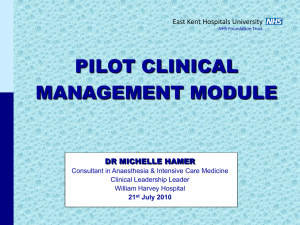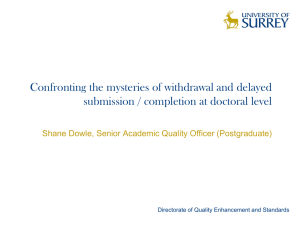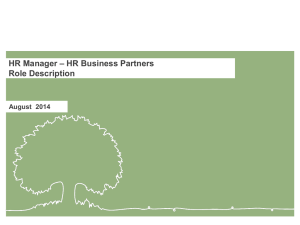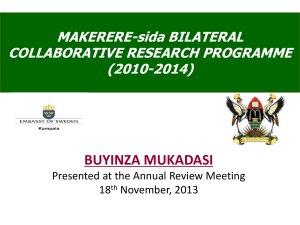2010 TCT Refresher - USCGAUX D11NR Operations
advertisement
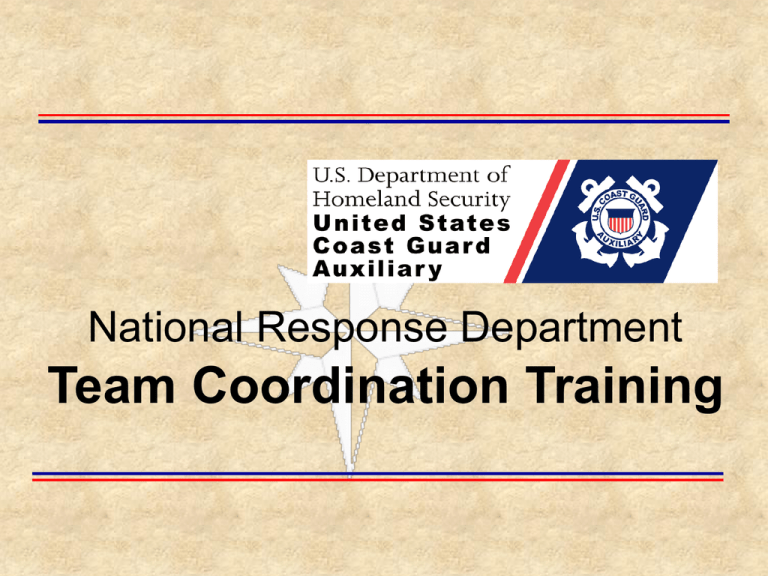
National Response Department Team Coordination Training Risk Management PART 1: Risk Management Team Coordination Training Response Directorate Risk Management Cont’d Operational Risk Management (ORM) applies to everyone in the Coast Guard Active Duty, Reserve, Auxiliary and Civilians. It standardizes and formalizes the Coast Guard’s ORM policy, Crew Resource Management (CRM) for aviators and TCT for surface operators. Team Coordination Training Response Directorate Risk Management Cont’d Operational Risk Management (ORM) applies to everyone in the Coast Guard Active Duty, Reserve, Auxiliary and Civilians. ORM consists of: • TCT • Briefing • De-Briefing Team Coordination Training Response Directorate Risk Management Cont’d Risk Management asks, and answers, these questions: What hazards exist? How can the mission be completed safely? Ultimate goal is to reduce: • mishaps • injuries • damage Team Coordination Training Response Directorate Hazard Risk Management Cont’d Risk Management boils down to: • • • • Humans make errors Mishaps are preventable Training is essential for mishap prevention TCT is an important tool for improving team performance Team Coordination Training Response Directorate The Team Risk Management reduces injuries and mishaps. Team Coordination Training (TCT) is a training program aimed at improving the way we look at risk and work as a team. Team Coordination Training Response Directorate The Team Team Coordination (TC) is a tool to prevent risk by employing seven critical elements. The TEAM concept focuses on group activities to accomplish goals. Team Coordination Training Response Directorate The Team Cont’d As part of Team Coast Guard, the Auxiliary must work together to prevent injuries while achieving the goal. The goal must be consistent with the Coast Guard’s core values and mission objective. Team Coordination Training Response Directorate The Team The Team Cont’d Human error continues to be the most significant cause of U.S. Coast Guard mishaps. 60-65% of cutter and boat navigation mishaps have had human error as a contributing cause. Team Coordination Training Response Directorate The Team Cont’d Mishap causes include: Poor judgment (67%), such as: • Unknown / misunderstood situation • Loss of situational awareness • Inadequate assessment of risks • Improper GO / NO-GO decisions • Incorrect information in decision making Team Coordination Training Response Directorate The Team Cont’d Mishap causes (cont’d): Inattention (16%), failure to: • Monitor information displays • Maintain a proper lookout • Use proper technique Team Coordination Training Response Directorate The Team Cont’d Mishap causes (cont’d): Ineffective Supervision (5%): • Lax enforcement of standards / procedures • Not verifying job done correctly • Lack of oversight Team Coordination Training Response Directorate The Team Cont’d Although there are no specific statistics regarding mishaps or casualties in the Auxiliary, active duty Coast Guard statistics can be used to better understand the nature and scope of the problem. Team Coordination Training Response Directorate CG Small Boat Mishap Rate Rate per 100,000 patrol hours Team Coordination Training Response Directorate Team Coordination Part 2: Team Coordination The 7 elements of TC are: 1. 2. 3. 4. 5. 6. 7. Leadership Mission Analysis Situational Awareness Adaptability and Flexibility Communication Assertiveness Decision-making Team Coordination Training Response Directorate Leadership Team Coordination Training Response Directorate Leadership Effective Leaders exhibit: • Courage • Confidence • Competence Leadership is not just about giving orders. Effective Leaders find ways to obtain the willing participation of others towards accomplishing a goal. Team Coordination Training Response Directorate Leadership Cont’d Leaders inspire and motivate others while managers give detailed directions to complete tasks by virtue of their position. Effective leaders earn the trust, respect, confidence, and loyalty of team members under their supervision. Team Coordination Training Response Directorate Leadership Cont’d • Leaders create an atmosphere of openness and trust within the team. • ALL team members, including leaders, should be approachable; suggestions from crew or a distressed vessel are thoughtfully accepted and acted upon if appropriate. • It is a courtesy to say “thank you” for all suggestions. Team Coordination Training Response Directorate Leadership Cont’d Effective leaders: • Update crew on mission progress • Balance workload among crew members • Ensure the crew is fully qualified • Provide feedback on performance Team Coordination Training Response Directorate Leadership Cont’d In Summary, effective leaders: • Make good decisions in a collaborative, team environment. • Have the courage to make the right decision, even if unpopular. • Exhibit confidence based on experience and ability. • Are competent, well prepared and mission oriented. Team Coordination Training Response Directorate Mission Analysis Team Coordination Training Response Directorate Mission Analysis The process by which operating and contingency plans are developed to safely and effectively accomplish the mission. • Operational plans must be preceded by information gathering such as: • Crew fitness • Mission specifics • Facility checklists • Weather forecast Team Coordination Training Response Directorate Mission Analysis Cont’d Operational plans (CONT'D): • Failure to gather accurate and comprehensive information and/or complacency affects the planning process and places the mission and crew at risk. • Contingency planning is critical as operational plans may change once implemented. Team Coordination Training Response Directorate Mission Analysis Cont’d Mission Analysis Includes: • Complexity of mission • Environmental factors • Crew fitness / selection / training Elements that impact Mission Analysis: • Crew safety (Priority!!!) • The mission Team Coordination Training Response Directorate Mission Analysis Cont’d Operational Risk Management (ORM) plays an important role in Mission Analysis. Always conduct a risk assessment with your crew prior to all patrols or missions. GreenAmber-Red (GAR). Continually assess and update risk assessment throughout the mission with your crew. GAR is a Team Coordination tool for ORM. Team Coordination Training Response Directorate Mission Analysis Cont’d A GAR assessment is part of an accepted way to plan and prepare for a mission. The other parts are Pre- and Post- Underway Briefs and the Pre-Underway Check List. Areas of Responsibility (AORs) may use differing GAR tools to assess risk. Team Coordination Training Response Directorate Mission Analysis Cont’d Sample GAR Worksheet Use the GAR form approved in your AOR. There may be additional explanatory pages to a form. Team Coordination Training Response Directorate Mission Analysis Cont’d • Accept no unnecessary risk • Accept necessary risk only when benefits outweigh costs • Make risk decisions at the appropriate level • ORM is just as critical in execution as in planning Team Coordination Training Response Directorate Situational Awareness Team Coordination Training Response Directorate Situational Awareness •All team members are responsible for situational awareness, not just the coxswain •Know what is going on all around, including aboard the vessel •Plans are critical to success; be ready to change plans based on new information or situations •Situational awareness is critical to good decision making Team Coordination Training Response Directorate Situational Awareness Group Activity How might we lose our Situational Awareness? Identify as many barriers to maintaining good situational awareness as possible. Name some ways to avoid these barriers and correct loss of situational awareness. Team Coordination Training Response Directorate Situational Awareness Cont’d Barriers to situational awareness: • Confusion over / pre-occupation with task • Lethargy, fatigue, loss of focus • Complacency, inactivity, boredom • Neglect of proper procedure • Environmental factors, e.g.: Weather Engine noise Sea state Team Coordination Training Response Directorate Situational Awareness Cont’d Loss of Situational Awareness Two-Challenge Rule If a team member has two or more omissions or questionable actions, the individual is assumed to have lost situational awareness. Immediate steps must be taken to re-establish a healthy, alert environment on board the facility. Team Coordination Training Response Directorate Situational Awareness Cont’d Loss of Situational Awareness may be prevented by: • Including crew in initial mission analysis • Rotating duties on a regular basis • Training exercises such as man overboard & line throwing evolutions, etc. • Varying the speed and direction of the vessel or aircraft when possible Team Coordination Training Response Directorate Adaptability Team Coordination Training Response Directorate Adaptability Effective team members including the coxswain adapt and are open to new information. Adaptability - Able to react to changes in: • Environmental conditions • Mission factors or complexity • Crew fitness • Equipment failures, etc. Team Coordination Training Response Directorate Adaptability Cont’d Leaders acknowledge that new information and/or crew input can change the mission. All team members must maintain situational awareness so changes are quickly identified and prioritized. Team Coordination Training Response Directorate Adaptability Cont’d Leaders leverage everyone’s ideas and experience. Leaders encourage team members to remain flexible and adapt to new conditions, ideas and challenges. Team Coordination Training Response Directorate Adaptability Cont’d Suggested Group Activity Group Activity • Adaptability means we are open to change • Take a few minutes now to identify the kind of new information that could cause us to change our operational plan • From where or what sources might that new information come? Team Coordination Training Response Directorate Communication Communication is the KEYSTONE of ALL Team Coordination Team Coordination Training Response Directorate Thanks to Wikipedia Communication Cont’d Effective communication is: • verbal and/or non-verbal • clear and concise • understood Words We Use Nonverbals, Body Language How We Say Words, Sounds We Make Team Coordination Training Response Directorate Communication Cont’d Leaders and crew have equal responsibility to ensure that thoughts and information are conveyed effectively. A “feedback loop” is a simple method to ensure that transmissions are heard and clearly understood. Team Coordination Training Response Directorate Communication Cont’d The “feedback loop” acknowledges all communications by: • Repeating the message • Finding a non-verbal method of acknowledging the message, depending on the situation Always ask for feedback or observe behavior to be sure that the message was received correctly. Team Coordination Training Response Directorate Suggested Group Activity Barriers to Good Communication • Barriers can develop that short circuit or degrade the quality of communication. • What kinds of barriers may exist that we can overcome with a little thought ? Team Coordination Training Response Directorate Suggested Group Activity • • • • Some Barriers might be: Failure to close the feedback loop Distracting “background noise” such as engine, wind and other physical environmental factors Over-complicating the message. Use the KISS method if possible (Keep It Simple Stupid) Fatigue Team Coordination Training Response Directorate Assertiveness General Patton in 1943 Team Coordination Training Response Directorate Assertiveness Assertiveness: Ability of individual team members to state and maintain a position that may be unpopular, or counter to a position taken by others, unless (until) convinced by facts and logic, and not based solely on the authority or personality of others. Team Coordination Training Response Directorate Assertiveness Cont’d Be assertive, but not aggressive. • The aggressive person seeks to bully his/her way through situations for their own ego or self image. • An assertive person cares more about the “mission” than their ego. Attempt to communicate concerns without offending those who disagree. Team Coordination Training Response Directorate Assertiveness Cont’d Summary: • • • • Ask task-related questions Suggest positive alternatives State opinions calmly but firmly Avoid letting perceived authoritative differences threaten mission performance • Avoid conflict, focus on mission Team Coordination Training Response Directorate Decision Making Which one, Which one?? Niagara Falls Thanks to Wikipedia Team Coordination Training Response Directorate Decision Making Group Activity What are the basic steps that might be taken in the decision making process? Team Coordination Training Response Directorate Decision Making Group Activity Decision making should include: 1. 2. 3. 4. 5. 6. 7. Defining a problem or condition Seeking information Analyzing & verifying desired outcome Identifying possible alternatives Selecting appropriate alternative Implementing and examining results Adjusting actions according to results Team Coordination Training Response Directorate Decision Making Cont’d Making good decisions is the heart of Team Coordination. Decisions may impact team safety and mission success. The first six elements of TC prepare us to make better decisions. The decision making process is a continuous evaluation of these steps throughout the mission. Team Coordination Training Response Directorate Decision Making Cont’d The decision making process can take 20 seconds for routine decisions or 20 months for complex problems. The process is the same - the depth of analysis and degree of complexity is always changing. Team Coordination Training Response Directorate GAR Model GAR was 14 when they left What is GAR now? Team Coordination Training Response Directorate Green-Amber-Red Model What is the level of risk? Is the level of risk manageable by the unit? 0 23 44 60 GREEN (Low Risk) AMBER (Caution) RED (High Risk) GO, no change in control is required GO, with adjustment of controls for risk NO GO, beyond normal operating limits GAR Considerations SUPERVISION: Coxswain’s experience, factoring in OPCON/OGA’s oversight for mission PLANNING: amount of information available, time and equipment needed CREW SELECTION: experience level of crew, trainees? Team Coordination Training Response Directorate GAR Considerations Cont’d CREW FITNESS: physical and mental state of crew ENVIRONMENT: factors affecting personnel and performance of facilities EVENT / EVOLUTION COMPLEXITY: time required and difficulty for the mission. Team Coordination Training Response Directorate GAR is broken down into 6 categories and scored 0 (low or no risk) to 10 (high or catastrophic risk) For Example: Supervision Planning Crew selection Crew Fitness Environment Event Complexity Rate 0-10 Rate 0-10 Rate 0-10 Rate 0-10 Rate 0-10 Rate 0-10 TOTAL 3 3 4 3 2 3 18 Team Coordination In summary: Team Coordination is one of the tools of Risk Management. Risk Management is a way of asking these questions: • What hazards exist? • How can the mission be completed safely? Team Coordination Training Response Directorate Team Coordination In summary (Cont'd) Risk Management can be a simple system of using common sense to avoid errors, or it can be complex methodology that must be employed in larger scaled operations. The ultimate goal is the same: • Reduce mishaps, injuries and damage • Achieve mission goals Team Coordination Training Response Directorate Team Coordination Training - Review Team Coordination is a method used to implement Risk Management. Team Coordination is comprised of these 7 elements: 1. 2. 3. 4. 5. 6. 7. Leadership Mission Analysis Situational Awareness Adaptability and Flexibility Communication Assertiveness Decision-Making Team Coordination Training Response Directorate Team Coordination – Review Continued • The Green-Amber-Red (GAR) form is a tool to determine what risks may be present and calculate the extent and seriousness of those risks. • Good decisions reduce or eliminate those risks while keeping everyone safe while accomplishing the mission. Team Coordination Training Response Directorate Team Coordination Training Final Questions or Comments? Team Coordination Training Response Directorate Thank You Thank you for your participation in the Team Coordination Training. Team Coordination Training Response Directorate
